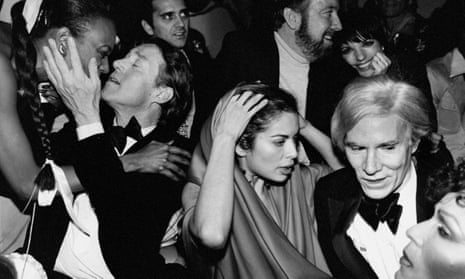It was really difficult to get in
Footage shows co-founder Steve Rubell cherrypicking on the door, reprimanding one hopeful with the immortal line: “Don’t ever come here with a hat.” Doorman Mark Benecke was charged with deciding on the chosen ones. The crowds only grew as the club’s popularity did. Writer and socialite Anthony Haden-Guest describes the scenes as “like the damned looking into paradise”.
It was the right place, right time
America in 1977 was ripe for something fun, glamorous and a bit risque. In the aftermath of the Vietnam war, Rubell said people were “tired of being serious – everyone went out and went wild”. The late 70s also saw the rise of celebrity culture, and Studio 54 provided that too, with Liza, Michael, Andy, Bianca and Diana regulars. The club was a tabloid fixture.
Celebrities shared their space with characters
Studio 54 was a safe space for groups who would have been marginalised in the late 70s. Trans women were welcomed, while eccentrics such as Rollerina, a Wall Street banker by day who rollerskated on the dancefloor at night, and Disco Sally, a 78-year-old lawyer, were cult figures.
It was sexy times a go-go
There was an “anything goes” attitude to sex at Studio 54. Mattresses in the basement were frequently the site of trysts, while the infamous balcony was designed – complete with easy-to-clean surfaces – as a place for couples to get it on. “Even if you weren’t having sex with someone every night, you felt like you could,” says former editor of Interview, Bob Colacello. Aids later hit, of course. Many of the staff of Studio 54 – including Rubell – died as a result of it.
It was money that stopped the party in the end
In 1978, Rubell told New York magazine that “only the mafia does better than us”. Suddenly the IRS were interested in going clubbing. On finding Studio 54’s books, it was discovered that a skim was in operation on up to 80% of the profits. Club founders Ian Schrager and Rubell were sent to jail in 1980. A party was staged the night before their sentences began. Diana Ross and Liza Minnelli sang, while Rubell blasted out My Way.
The end of Studio 54 was also the end of disco
Schrager and Rubell’s time in prison coincided with the infamous Disco Sucks event in 1979, where disco records were burned at a baseball game while around 50,000 people watched. Rogers says this was a reaction to people seeing images of the glamour of places like Studio 54 while their real lives reflected “the worst financial recession since the Great Depression”.
Studio 54 is in cinemas now

Comments (…)
Sign in or create your Guardian account to join the discussion